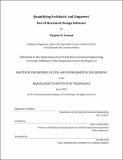Quantifying architects' and engineers' use of structural design software
Author(s)
Arnaud, Virginie B. (Virginie Blandine)
DownloadFull printable version (6.086Mb)
Other Contributors
Massachusetts Institute of Technology. Department of Civil and Environmental Engineering.
Advisor
John A. Ochsendorf.
Terms of use
Metadata
Show full item recordAbstract
Both architects and engineers encounter significant barriers and hurdles that compartmentalize both fields and increase the complexity of collaborative design. In addition to little interaction between both fields, software programs are limited in many aspects. That is why the current industry's organization and tools confront engineers and architects with significant challenges. If improvements are made, they would reduce designers' effort and the time spent to overcome these challenges, and would positively impact the quality of their work. Thus, it is necessary to identify problems in current tools and to study the design process to find areas for improvement in design software programs. This paper presents a discussion on the limitations of structural design software and a study on the differences between architects and engineers during the design process through the analysis of the use of a newly developed framework: StructureFIT. This tool was recently developed at MIT and aims to create an interface between both disciplines. In this thesis, a usability study and a questionnaire were specifically designed to gather data from 38 graduate students of architecture and engineering. This material aims to assess users' level of satisfaction with current tools, identify the areas to be improved in current software programs, quantify the differences in designers' practices, and assess StructureFIT. The analysis of findings suggests that users are not fully satisfied with current tools. The reason is that most design tools do not easily foster the exploration of structural alternatives due to lack of user-friendliness, compared to StructureFIT that did meet the users' demands. This work also provides a better understanding of engineers' and architects' respective design approaches as discussed through the analysis of the usability study results. Lastly, StructureFIT does provide a positive design exploration for designers, since the tool enabled users to dramatically improve structural performance while providing a wide diversity of solutions. The richness of generated efficient design solutions is what makes StructureFIT an innovative and promising approach.
Description
Thesis (M. Eng.)--Massachusetts Institute of Technology, Dept. of Civil and Environmental Engineering, 2013. This electronic version was submitted by the student author. The certified thesis is available in the Institute Archives and Special Collections. Cataloged from student-submitted PDF version of thesis. Page 137 blank. Includes bibliographical references (p. 135-136).
Date issued
2013Department
Massachusetts Institute of Technology. Department of Civil and Environmental EngineeringPublisher
Massachusetts Institute of Technology
Keywords
Civil and Environmental Engineering.